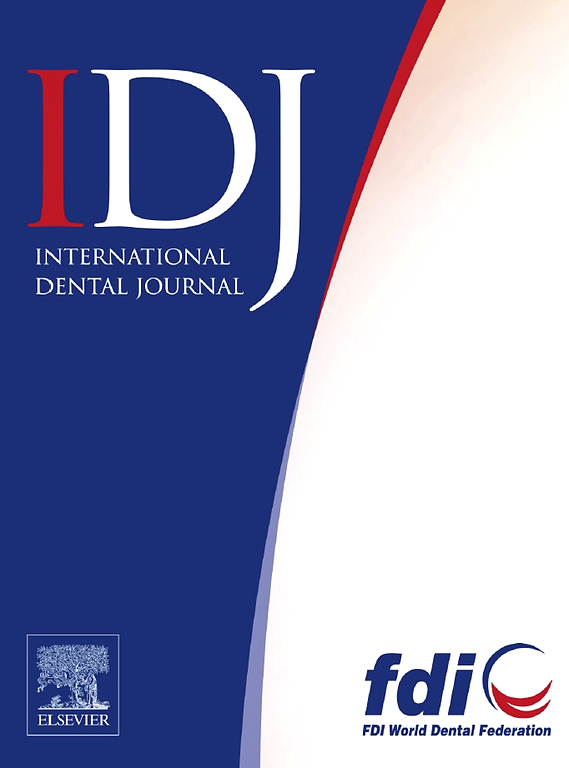Bioinformatics Analysis and Experimental Validation of Disulphidptosis in Oral Squamous Cell Carcinoma
IF 3.7
3区 医学
Q1 DENTISTRY, ORAL SURGERY & MEDICINE
引用次数: 0
Abstract
Introduction and Aims
Oral squamous cell carcinoma (OSCC) is a highly aggressive relatively common cancer that poses a serious threat to patient health, leading to significant economic burdens on healthcare systems. This study was designed to investigate the expression levels of disulphidptosis-related genes (DRGs) in OSCC and assess their potential as biomarkers for diagnosis and prognosis.
Methods
We used in-depth bioinformatics analysis of RNA sequencing data from the public databases, as well as functional enrichment analysis, survival analysis, immune cell infiltration levels and single cell analysis, to assess DRG expression in OSCC samples. Fifteen highly elevated DRGs, including inverted formin 2 (INF2) and destrin (DSTN), were investigated, and their expression in OSCC samples was validated by real-time PCR.
Results
The expression of these 15 DRGs correlated with patient survival rates and immune cell infiltration patterns. Functional enrichment analysis revealed that these genes are engaged in the regulation of essential biological processes, including the cytoskeleton and focal adhesion, indicating their importance in tumour development and tumour microenvironment interactions. Furthermore, receiver operating characteristic analysis revealed that the area under the curve for these DRGs ranged between 0.651 and 0.932, indicating their potential as diagnostic and prognostic biomarkers. The mRNA expressions of INF2 and DSTN were increased in OSCC samples. Single-cell RNA sequencing analysis emphasised the predominant expression of DRGs in cancer cells.
Conclusion
INF2 and DSTN could serve as valuable biomarkers for the early detection and prognosis of OSCC, potentially impacting future therapeutic strategies. However, further research, including laboratory validation and clinical trials, is essential to explore the therapeutic targeting of INF2 and DSTN and their effects on the immune microenvironment in OSCC.
Clinical relevance
INF2 and DSTN have been shown to be independent predictors of overall survival and progression-free survival in OSCC patients. Integrating tumour node metastasis staging with these DRG features could significantly improve the accuracy of prognosis prediction. This will help clinicians to more accurately assess the risk of recurrence and death in patients, and to guide more individualised plans for postoperative follow-up intensity and frequency.
口腔鳞状细胞癌二硫下垂的生物信息学分析及实验验证。
口腔鳞状细胞癌(Oral squamous cell carcinoma, OSCC)是一种高度侵袭性的相对常见的癌症,对患者健康构成严重威胁,给医疗保健系统带来了巨大的经济负担。本研究旨在探讨二硫中毒相关基因(DRGs)在OSCC中的表达水平,并评估其作为诊断和预后生物标志物的潜力。方法:利用公共数据库的RNA测序数据进行深入的生物信息学分析,以及功能富集分析、存活分析、免疫细胞浸润水平和单细胞分析,评估OSCC样本中DRG的表达。研究了15种高表达DRGs,包括倒置双胍蛋白2 (INF2)和destrin (DSTN),并通过实时PCR验证了它们在OSCC样品中的表达。结果:这15种DRGs的表达与患者生存率和免疫细胞浸润模式相关。功能富集分析显示,这些基因参与基本生物过程的调控,包括细胞骨架和局灶黏附,表明它们在肿瘤发展和肿瘤微环境相互作用中的重要性。此外,受试者工作特征分析显示,这些DRGs的曲线下面积在0.651至0.932之间,表明它们具有作为诊断和预后生物标志物的潜力。OSCC组织中INF2和DSTN mRNA表达升高。单细胞RNA测序分析强调DRGs在癌细胞中的优势表达。结论:INF2和dsn可作为OSCC早期发现和预后的有价值的生物标志物,可能影响未来的治疗策略。然而,需要进一步的研究,包括实验室验证和临床试验,以探索INF2和DSTN的治疗靶向性及其对OSCC免疫微环境的影响。临床相关性:已证明INF2和DSTN是OSCC患者总生存期和无进展生存期的独立预测因子。将肿瘤淋巴结转移分期与这些DRG特征相结合,可显著提高预后预测的准确性。这将有助于临床医生更准确地评估患者的复发和死亡风险,并指导更个性化的术后随访强度和频率计划。
本文章由计算机程序翻译,如有差异,请以英文原文为准。
求助全文
约1分钟内获得全文
求助全文
来源期刊

International dental journal
医学-牙科与口腔外科
CiteScore
4.80
自引率
6.10%
发文量
159
审稿时长
63 days
期刊介绍:
The International Dental Journal features peer-reviewed, scientific articles relevant to international oral health issues, as well as practical, informative articles aimed at clinicians.
 求助内容:
求助内容: 应助结果提醒方式:
应助结果提醒方式:


